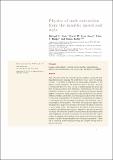Physics of melt extraction from the mantle : speed and style
Abstract
Melt extraction from the partially molten mantle is among the fundamental processes shaping the solid Earth today and over geological time. A diversity of properties and mechanisms contribute to the physics of melt extraction. We review progress of the past ∼25 years of research in this area, with a focus on understanding the speed and style of buoyancy-driven melt extraction. Observations of U-series disequilibria in young lavas and the surge of deglacial volcanism in Iceland suggest this speed is rapid compared to that predicted by the null hypothesis of diffuse porous flow. The discrepancy indicates that the style of extraction is channelized. We discuss how channelization is sensitive to mechanical and thermochemical properties and feedbacks, and to asthenospheric heterogeneity. We review the grain-scale physics that underpins these properties and hence determines the physical behavior at much larger scales. We then discuss how the speed of melt extraction is crucial to predicting the magmatic response to glacial and sea-level variations. Finally, we assess the frontier of current research and identify areas where significant advances are expected over the next 25 years. In particular, we highlight the coupling of melt extraction with more realistic models of mantle thermochemistry and rheological properties. This coupling will be crucial in understanding complex settings such as subduction zones. ▪ Mantle melt extraction shapes Earth today and over geological time. ▪ Observations, lab experiments, and theory indicate that melt ascends through the mantle at speeds ∼30 m/year by reactively channelized porous flow. ▪ Variations in sea level and glacial ice loading can cause significant changes in melt supply to submarine and subaerial volcanoes. ▪ Fluid-driven fracture is important in the lithosphere and, perhaps, in the mantle wedge of subduction zones, but remains a challenge to model.
Citation
Katz , R F , Rees Jones , D W , Rudge , J F & Keller , T 2022 , ' Physics of melt extraction from the mantle : speed and style ' , Annual Review of Earth and Planetary Sciences , vol. 50 , pp. 508-540 . https://doi.org/10.1146/annurev-earth-032320-083704
Publication
Annual Review of Earth and Planetary Sciences
Status
Peer reviewed
ISSN
0084-6597Type
Journal article
Description
Funding: This research received funding from the European Research Council under Horizon 2020 research and innovation program grant agreement number 772255. The authors thank the Isaac Newton Institute for Mathematical Sciences for its hospitality during the programme Melt in the Mantle which was supported by EPSRC Grant Number EP/K032208/1.Collections
Items in the St Andrews Research Repository are protected by copyright, with all rights reserved, unless otherwise indicated.

